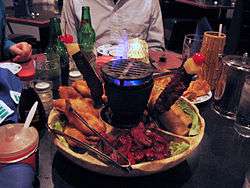Pu pu platter
A pu pu platter, pu-pu platter or pupu platter is a tray of American Chinese or Hawaiian food[1] consisting of an assortment of small meat and seafood appetizers. A typical pupu platter, as found in American Chinese cuisine, might include an egg roll, spare ribs, chicken wings, chicken fingers, beef teriyaki, skewered beef, fried wontons, crab rangoon and fried shrimp, among other items, accompanied by a small hibachi grill.
 | |
| Course | Hors d'oeuvre |
|---|---|
| Main ingredients | Meat and seafood |
| Pu pu platter | |||||||||||||
|---|---|---|---|---|---|---|---|---|---|---|---|---|---|
| Traditional Chinese | 寶寶盤 | ||||||||||||
| Simplified Chinese | 宝宝盘 | ||||||||||||
| |||||||||||||
The pupu platter was probably first introduced to restaurants on the United States mainland by Don the Beachcomber in 1934.[1] It has since become a standard at most Polynesian themed restaurants such as Don's and Trader Vic's.[2][3] The earliest known print reference to a pupu platter served at a Chinese restaurant is from 1969.[4]
Later, other types of restaurants used pu pu platter to mean an appetizer combination platter.[n 1] However, pu pu platters are currently more closely associated with American Chinese restaurants.[5][6]
Hawaiian origin and etymology
In the Hawaiian language, pū-pū denotes a relish, appetizer, canapé, or hors d'oeuvre; it originally meant "shell fish', but also referred to small bits of fish, chicken, or banana relish served with kava[7] and beans.
In Hawaiian cuisine
Since the introduction of commercial dining and drinking establishments in Hawaii, pūpū were, and remain, standard fare in island establishments.[n 2] An establishment that serves "heavy pupus" will often have a buffet table with warming trays full of chicken, tempura vegetables, shrimp, poke (cubed and seasoned raw fish), small skewers of teriyaki meat or chicken, sushi, and other similar finger foods. An establishment that serves "light pupus" usually will offer only the cold foods such as poke, sushi, and vegetables. Some establishments will serve pūpū to the table.
At Hawaiian bar, restaurants, catered events such as political rallies, and private parties, establishments, and hosts are known in "local" circles by the quality of their pupus. Event invitations often will state that "light pupus" or "heavy pupus" will be served so that attendees will know whether they should plan to have a full meal before the event or not.
Today, the simple platter of dried fish, grilled chicken, and slices of banana has evolved into chefs' offerings of international delicacies arranged for visual as well as gustatory pleasure. Modern pupu platters can hold offerings of anything from traditional Hawaiian fare to exotic combinations.
In Polynesian cuisine on the mainland
At the height of the tiki bar/restaurant craze, the New York Herald Tribune published several articles concerning the opening and the ambiance of one of the first Hawaiian themed restaurants in New York City, Luau 400, on East 57th Street. At the time of the restaurant's opening in 1957, pu pu platters were considered a part of the luau feast.[8] A typical platter at this establishment would have included baked clams, rumaki, Shrimp Vela (battered fried shrimp with coconut), chicken wings, egg rolls, spare ribs, or Javanese sate (satay) on skewers.[9] The appetizers were served on "a Lazy Susan made of monkey pod wood and equipped with a little stove fired with charcoal briquettes."[8] Recipes for some of the pu pu items were later published in the Herald Tribune in 1960.[10]
At one 21st-century tiki bar, the pu pu platter includes "Samoan deviled eggs, Chinese sausage and stick rice arancini, coconut shrimp and chilies stuffed with pork sausage."[11]
Notes
- In the 1970s, Boston area Italian restaurants were marketing their appetizers combinations as Italian pu pu platters."Tough question served to court on platter". The Boston Globe. April 22, 1975. p. 8.Alternate Link via ProQuest.
- Unlike in American Chinese cuisine, the Hawaiian dish is referred to simply as pūpū or pūpūs, without the word platter.
References
- Hartz, Deborah S. (July 9, 2003). "Carrying a torch for pupu platters". Chicago Tribune.
- Reichl, Ruth (September 30, 1994). "Restaurants: Seemingly designed for Eloise (and so convenient), the successor to Trader Vic's". The New York Times. p. C22. Link via ProQuest.
- Krummert, Bob (November 2002). "Tiki not so tacky". Restaurant Hospitality. 86 (11). p. 15. ISSN 0147-9989.Link via ProQuest.
- "Ad for a Chinese restaurant and their 'flaming pu pu platter'". The New York Times. July 18, 1969. p. 14. Link via ProQuest.
- O'Leary, Joanna (March 10, 2014). "A Brief History of the Pu Pu Platter". Houston Press.
- Yeh, Cedric (September 23, 2010). "Pu pu platters versus birthday cakes". O Say Can You See?. National Museum of American History.
- Mary Kawena Pukui and Samuel Hoyt Elbert (2003). "lookup of pūpū". in Hawaiian Dictionary. Ulukau, the Hawaiian Electronic Library, University of Hawaii Press. Retrieved November 15, 2010.
- Paddleford, Clementine (December 28, 1957). "Authentic Hawaii, East of First Ave". New York Herald Tribune. p. 9.Link via ProQuest.
- "Display Ad for Luau 400 Restaurant". New York Times. November 7, 1957. p. 43.Link via ProQuest.
- McGovern, Isabel A (April 3, 1960). "Luau dinner". New York Herald Tribune. p. F10.Link via ProQuest.
- Fabricant, Florence (September 8, 2010). "Fall Restaurant Preview; Is That Bali Hai Calling? The Tiki Bar Has Returned". New York Times.